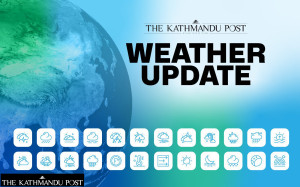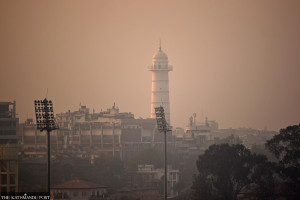Weather
Rain disrupts domestic flights, diverts international flight, blocks highways
Jazeera Airways flight diverted to Varanasi. More rains expected until Wednesday.
Post Report
Heavy rain and poor visibility on Sunday morning disrupted multiple domestic flights and forced a Kathmandu-bound international flight to divert to Varanasi, India.
Due to adverse weather conditions, no mountain flights operated on Sunday, according to officials at the Tribhuvan International Airport.
Similarly, three planes that took off with international tourists from Ramechhap airport for Lukla in Solukhumbu and another en route to Thamkharka airport were diverted due to heavy rain.
“No mountain flights took place today [Sunday] due to adverse weather conditions,” said Rinji Sherpa, spokesperson at the Tribhuvan International Airport. “Several other domestic flights from small airports were also diverted, but no flight was affected in major airports—Kathmandu, Pokhara, Biratnagar and other towns.”
Officials said a Kathmandu-bound Jazeera Airways flight was diverted to Varanasi, India, due to severe weather.
The Meteorological Forecasting Division under the Department of Hydrology and Meteorology said that most places throughout the country witnessed light to moderate rainfall on Sunday morning. But some places witnessed heavy rainfall that triggered floods and landslides.
According to the Met Office, Chitwan recorded 68.2 mm rainfall, followed by Okhaldhunga 64.8, Lamidanda of Khotang 54 mm, and Morang 53.4 mm. Hetauda of Makawanpur recorded 44 mm rainfall, and Sindhupalchowk saw 33.6 mm.
An update on highway obstruction issued by Nepal Police stated that incessant rain completely halted vehicular movement in the East-West Highway at Chausathi in ward 2 of Binayi Tribeni Rural Municipality in Nawalparasi East, and flood partially halted the same highway at Binayi River in ward 1 of the rural municipality. Likewise, continuous rainfall completely obstructed Kanti Lokpath in ward 2 of Bagmati Rural Municipality in Makawanpur.
Similarly, vehicular movement was blocked on the Araniko Highway at Bhotekoshi of Sindhupalchok and Prithvi Highway at Krishnabhir of Dhading. Hundreds of commuters were stranded for hours due to the obstruction.
The Met division said rainfall has occurred for a couple of days and will continue until Wednesday. Moisture incoming from the Bay of Bengal and the local system, along with the westerly wind, is responsible for rainfall in many places across the country, which is a normal pre-monsoon phenomenon.
According to the three-day bulletin issued by the Met Office, most places throughout the country remained partially to fully cloudy on Sunday. Hilly areas of Koshi, Bagmati, Gandaki and Lumbini provinces witnessed light to moderate rain accompanied by thunder, lightning, and strong winds. There is a chance of heavy rain in a few places in the Gandaki and Lumbini provinces. A chance of light snowfall is likely in the mountainous region of Koshi, Bagmati, Gandaki provinces, according to the met officials.
Rain for around a week has dropped temperatures by several degrees.
According to the latest update by the division, Nepalgunj recorded 35.5 degrees Celsius, Bhairahawa and Simara 33.4 respectively,Dharan 33.3, Janakpur 33.2, Dhangadhi 32.2, and Dipayal 31 degrees Celsius. Kathmandu recorded 23.7 degrees Celsius.
Last year, heatwave conditions affected hundreds of people in the country’s southern belt. A heat wave occurs when the maximum and minimum temperatures at a location are unusually high continuously over a three-day period.
Meanwhile, in 2025, Nepal is likely to witness above-normal monsoon rains for the second consecutive year, according to a regional consensus among South Asian meteorologists. This has sparked optimism over better crop yields and provided a much-needed lift for the country’s struggling economy.
But the forecast also comes with a warning. Above-normal rains could spell more disasters, including flash floods and landslides.
However, some parts in the north, south, east, and northeast of South Asia may experience normal to below-normal rainfall.
A statement issued by the 31st Session of the South Asian Climate Outlook Forum on April 29 indicated that most parts of South Asia are expected to receive above-normal rainfall during the 2025 southwest monsoon season, which spans from June to September. However, some parts in the north, south, east, and northeast of South Asia may experience normal to below-normal rainfall.
The regional climate outlook was jointly prepared by all nine National Meteorological and Hydrological Services of South Asia, with the assistance of international experts, during the Pune, India session.




 23.5°C Kathmandu
23.5°C Kathmandu





